The city will cancel the bids for the construction of the Downtown Seawalk leading to a bronze whale statue after they came in millions higher than the estimated cost.
Only two bids came in for the project, which was estimated to cost slightly more than $11 million. The lower of the two bids was nearly $14 million — about 25 percent more than the engineer’s estimate. The other bid was about $3.5 million more than projected.
“With this one, we need to look at it and say ‘OK are there ways we can adjust it? Maybe take some things out?’” said City Manager Kim Kiefer. “The options here are cutting pieces out or adding money to it.”
Rorie Watt, the city’s director of engineering, said that one or the other — or both — will likely have to happen. It’s still too early to say how exactly the city will move forward with this project, but cancelled bid process will likely delay the completion date set for next fall by about six months. Watt hopes to have a new bid out for the project within a few weeks, but first he has to find out what caused this bid to go sideways.
Each bid package provides contractors with a specific outline for the project they’re bidding on. These packages contain everything from directions and timelines to cost estimates for everything down to the planting soil and bark mulch. They also provide a “great degree of detail,” Watt said, to make sure that city is able to control the vision for the project and to keep costs down. This is because the city is required to award the project to the lowest “responsive and responsible” bidder.
“When it works well, you get great pricing,” Watt said. “It just didn’t work well in this case.”
The problem is that both of the contractors who bidded on this project — North Pacific Erectors Inc. and Dawson Construction Inc. — and the city had wildly different estimates for many of the project’s components. For instance, the city estimated that the water feature piping for the whale sculpture would cost about $300,000. North Pacific Erectors, however, estimated this piping to cost more than $900,000, and Dawson Construction estimated it would cost $475,000. The bids were full of such discrepancies.
“I had to get out my Ouija board to try and understand why the contractors did things the way they did,” Watt said. “Obviously, we’re all not operating on the same assumptions.”
And in order to fix the bid package so that the city can put it out for a second try, Watt has to make sure that the city and any potential contractors are on the same page. He will be meeting with contractors during the next few weeks to try to ensure a more successful second round of bidding, but for now the city is “back at square to step one” in the bidding process.
Kiefer said that it isn’t unusual for bids to come in over the city’s estimated cost, and Watt agreed. He has seen several bids go over the city’s estimates during his time here, but they don’t typically run over by such a large margin.
According to Watt, roughly 90 percent of bids come in less than the engineer’s estimate, and about half of the remaining 10 percent come in more expensive than the estimate but are still affordable. The case of the Downtown Seawalk project, however, falls safely within the remaining 5 percent of bids: the ones that come in over the estimate and that are too pricey too move forward with as planned.
Though city estimates are on target far more frequently than they’re not, this isn’t the first time Watt has seen a bid so far removed from estimate. Between 2006 and 2007, the engineer’s estimates missed their mark fairly often, he said. As the national economy headed into a recession, the price of commodities such as copper and oil skyrocketed, outpacing the city’s bid estimates.
Though the city doesn’t yet know what caused this bid process to be so far off, Watt said he thinks that the city may have underestimated how competitive the construction market currently is. This may have led an engineer’s estimate that was lower than it should’ve been.
“I think we have to admit that our optimism was a little excessive,” Watt said.
But there are certainly other factors that likely played into the discrepancy between the engineer’s estimate and the bids received. Projects like the Seawalk can be difficult to estimate and to bid on because they lack the precedent that comes with other, more frequently bid projects. Both parties generally have a better understanding of cost when dealing with projects like roofing or building small structures.
“Contractors can’t just say ‘Hey, what did we bid on the last Seawalk and giant whale project?’” Watt said.

